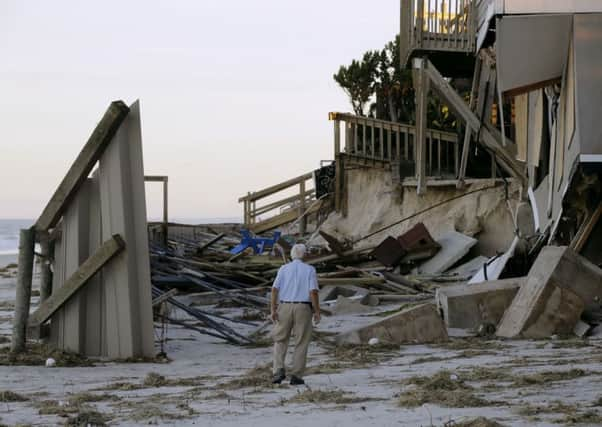Hurricane Matthew kills 10 in US


The hurricane was blamed for at least 10 deaths in the US, including that of a 68-year-old Georgia man who died when two trees fell on his home. And hundreds were left dead in Matthew’s wake in Haiti.
By Saturday night, North Carolina felt the brunt of Matthew, with more than a foot of rain falling in the south-eastern part of the state, causing life-threatening flash flooding, forecasters said. Homes, businesses and roads as far west as Raleigh were also damaged by the deluge.
Advertisement
Hide AdAdvertisement
Hide AdBut in many places along the sout-east coast, the damage consisted mostly of flooded streets, blown-down signs and awnings, flattened trees and power cuts.
As the storm passed and the skies cleared, many people were already cleaning up, reopening their businesses or hitting the beach. The power started coming back on and all three major theme parks in Orlando, Florida, including Walt Disney World, were up and running.
“We are all blessed that Matthew stayed off our coast,” Florida governor Rick Scott said. “We are blessed that we didn’t have a direct hit.”
On Saturday, Matthew sideswiped two of the South’s oldest and most historic cities - Savannah, Georgia, and Charleston, South Carolina - and also brought torrential rain and stiff wind to places like Myrtle Beach, South Carolina, and Wilmington, North Carolina.
From there, it was expected to veer out to sea, lose steam and loop back around towards the Bahamas and Florida, but too feeble to cause any trouble.
For nearly its entire run up the coast from Florida, Matthew hung just far enough offshore that communities did not feel the full force of its winds.
Its storm centre, or eye, finally blew ashore just north of Charleston on Saturday, but only briefly. And by that time Matthew was just barely a hurricane, with winds of just 75mph.
But Matthew’s deadly potential was made all too clear in Haiti, where the hurricane roared ashore on Tuesday with terrifying 145mph winds. At least 470 people were reported dead in one hard-hit district alone, with other devastated areas still unreachable four days later.
Advertisement
Hide AdAdvertisement
Hide AdIn the US, an estimated two million people in the south east were ordered to evacuate their homes as Matthew closed in. By hugging the coast, the storm pretty much behaved as forecasters predicted, but a shift of just 20 or 30 miles could have meant widespread devastation.
“People got incredibly lucky,” Colorado State University meteorology professor Phil Klotzbach said. “It was a super-close call.”
While Matthew’s wind speed had dropped considerably by the time it hit the south east coast, the storm will still go down as one of the most potent hurricanes on record, based on such factors as wind energy and longevity, and one of the most long-lived major hurricanes, too.
It was a major hurricane - that is with winds of at least 110mph - for 7.25 days.
The storm swamped the streets of Savannah, a historic town of moss-draped squares and antebellum mansions. A homeless woman was seen staggering through waters up to her neck. She made it across safely.
A coastguard helicopter crew also rescued a man stranded on a sailboat in a river near Georgia’s Tybee Island and North Carolina officials had to rescue numerous people from cars and homes.